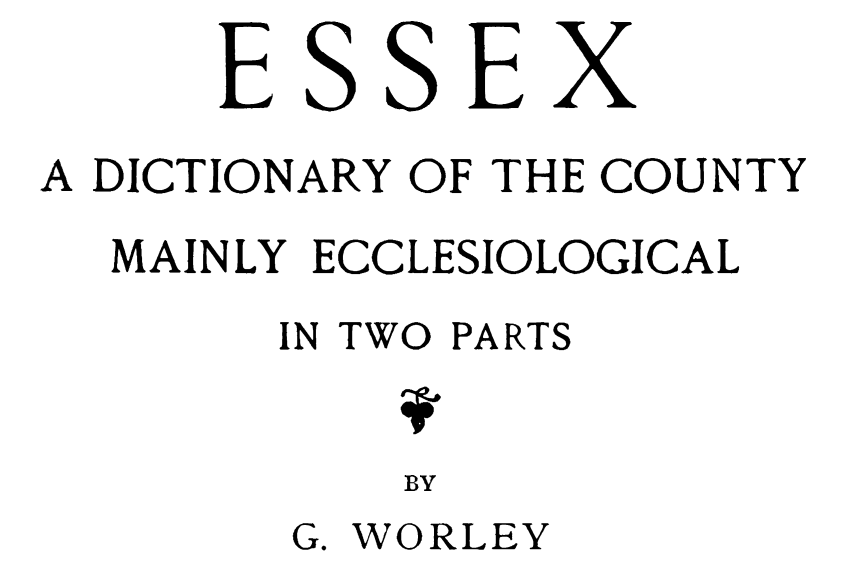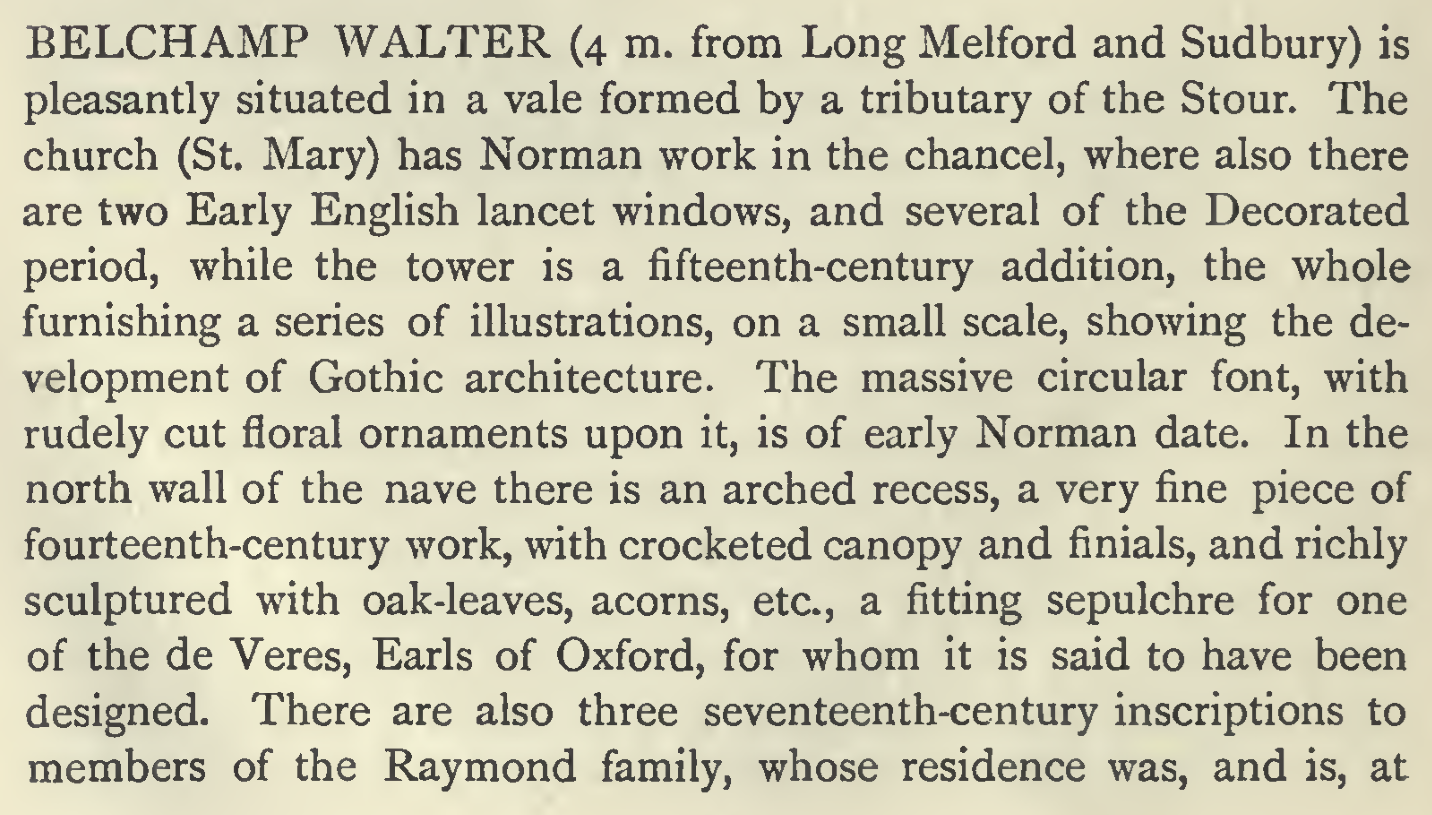Essex, G. Worley 1915
As an example of historical texts, books and manuscripts that require a large measure on "interpretation",
the book "Essex: A Dictionary of the County Mainly Ecclesiological" by G. Worley, 1915, is a good example.
In the north wall of the nave there is an arched recess , a very fine piece of fourteenth-century work,
with crocketed canopy and finials, and richly sculptured with oak-leaves, acorns, etc.
, a fitting sepulchre for one of the de Veres, Earls Of Oxford, for whom it is said to have been
designed.
The "arched recess" is the entry to the Botetourt chantry and NOT "designed" for one of the de Veres.
Reflection on the state of the Church of England in 1915
Worley's account of Essex in 1915 is more a reflection of how the Church of England was divided up at the
start of the Twentieth Century than it is a historical record.
True, the title of the book does say "Mainly Ecclesiological", but that is no excuse for getting the facts
wrong! Worley does not specify his sources in the sections for the individual parishes although he does credit
many sources in his introduction. It is for this reason it is difficult to know where the statements regarding
provinance of the Chantry in Belchamp Walter.
Worley is more interested in when the Parish registers date from and what parishes are being incorporated with
other diocese outside the county of Essex. For example the villages of Ballingdon and Bulmer, Ballingdon
(presumably All-Saints Sudbury) being assigned to St. Edmundsbury. Sturmer
Top
The work "Essex: A Dictionary of the County Mainly Ecclesiological" by G. Worley, 1915 also makes
no mention of the wall paintings (or at least the free version doesn't) and goes on to describe
the Raymond family. As there is an inaccurate explaination of the chantry I cannot believe that the
account of the Raymonds is in any way accurate.
The introduction from G. Worley:
IN proportion to its size, there is probably no county in
England that is better worth exploring than Essex. The
dimensions are stated differently by different geographers,
and have in fact varied to some extent from time to time
with the action of the sea, which has here given and taken
land in its capricious movements, as it has done all round
our island, and particularly along the eastern coast. Disre
garding the projection towards the Naze on "that side, the
county may roughly be described as a square. It measures
about forty-four miles from north to south, and rather more
from east to west, a diagonal line drawn across from Stratford
to Harwich giving us seventy-two miles as the greatest length,
the total area being estimated at 986,975 statute acres on the
latest ordnance survey.
It is a popular but mistaken notion that Essex is flat and
uninteresting. True though this may be of that portion which
lies immediately to the north of the Thames estuary, and of
the eastern margin, as belonging to that great plain which
stretches thence across Holland into Central Europe, it is
certainly not true of the county as a whole. The greater part
of its surface inland is covered with gently undulating hills
and dales, well wooded and well watered, occasionally rising
into heights of some distinction, as at High Beech (759 feet
above the sea-level), and at Danbury and Laindon Hills (re
spectively 600 and 620 feet), from whose summits a picturesque
landscape may be seen in all directions, to disprove the fore
mentioned libel on the county as deficient in natural beauty.
But whatever it
may lack in that respect, as compared with
the more romantic scenery of other districts, is amply com
pensated to the antiquary and ecclesiologist by the marks of
their presence left upon the land by its former inhabitants.
Parish Registers
Worley makes an interesting observation about the keeping and the survival of Parish Registers. He observes
that many records have been lost prior to 1558 and during the Civil War and the Interegnum (1649-1660).
Thomas Cromwell issued an injunction in 1538 in his role as Secretary of State and
Master of the Rolls that instructed churches to keep registers. This did not go well as was not very popular
due to his activities in the Acts of Dissolution, those that started and kept the registers seemed to have
entered names that did not actaully reflect those that had dealings with the church. In fact it seems that
the registers were more of a political statement.
Due to the "abuse" that was made of his request Queen Elizabeth issued futher instrctions in 1558 for
better keeping of parish records:
...... will partly account for the very general neglect of his instructions; to which we may add the laxity of the
parochial clergy in the performance of an unaccustomed duty,
previously discharged (at least as regards the registration of
important deaths) by the monasteries. To correct the mischief, Queen Elizabeth issued a stringent order in 1597 for
the better keeping of the parish registers, and that transcripts of them should be sent every year to the
respective diocesans.
That this order was not properly obeyed seems clear from the subsequent issue of another, directing that new books
should be made, with leaves of vellum instead of paper, containing all the old records, "
more especially from the begining of the Queen's reign in 1558."
The clause was unfortunately worded;
and in many parishes advantage was taken of the loophole which it afforded to
neglect the older entries altogether, or simply make selections
from them at the transcriber's discretion.
This will sufficiently account for the date at which so large a number of
registers commence.
Anyone looking through them from
that time forward will be led to notice many an hiatus which
will probably never be filled up, and (in some cases) remark
ably few entries of more than mere local and temporary in
terest.
This species of laxity is specially noticeable during the
interregnum (1649-60), when many valuable records were lost
beyond recovery, in the practical extinction of the National
Church. At Fryerning, for instance, which may be taken as
an illustration of the general neglect, there is no allusion to
the Puritans or the Civil War, or to the state of the parish
under visitations of the plague; though there are hundreds of
entries of burials, without the slightest information as to the
cause of death, or the age and station of the deceased, whose
names alone are given against the dates.
The entry for Belchamp Walter
I have left the formatting pretty much as Worley presented it.
BELCHAMP WALTER (4 m. from Long Melford and Sudbury) is
pleasantly situated in a vale formed by a tributary of the Stour. The
church (St. Mary) has Norman work in the chancel, where also there
are two Early English lancet windows, and several of the Decorated
period, while the tower is a fifteenth-century addition, the whole
furnishing a series of illustrations, on a small scale, showing the de
velopment of Gothic architecture. The massive circular font, with
rudely cut floral ornaments upon it, is of early Norman date. In the
north wall of the nave there is an arched recess, a very fine piece of
fourteenth-century work, with crocketed canopy and finials, and richly
sculptured with oak-leaves, acorns, etc., a fitting sepulchre for one
of the de Veres, Earls of Oxford, for whom it is said to have been
designed. There are also three seventeenth-century inscriptions to
members of the Raymond family, whose residence was, and is, at
The Hall, a large mansion in the semi-classical style of Queen Anne's
reign. Mrs. Raymond is now the patroness of the living, which goes
with Bulmer {q.v) in the same neighbourhood. The tower contains
eight bells, besides one for the clock, none ancient. Registers from
1559.
Apart from the de Vere statement (see above) the writing of registers on vellum is a confirmation of what was
written in the church guide of 1965. I suspect that the wording was a mix
of Worley and Raymond.
REGISTERS
In the year 1559 Queen Elizabeth I ordered registers to be kept in all Churches.
In 1623 William Smythies was appointed Vicar. He not only kept the registers most
beautifully, but also copied out entries of his predecessors from 1559 onwards in a
vellum bound book. The current registers are preserved in the Church safe, but the
older registers are kept in the Essex County Archives.
I am not sure about the whereabouts and accuracy of the current registers. The burial register for the
cemetary, which is administered by the Parish Council, are maintained by the clerk of the Parish Council and
the Burial register is also posted on this website. The period covered is from 1920 to the present.
Worley's text in the Google Index
The observation that Worley's text is in the Google Index may mean that I have to remove it from the server
and also the Google Index.
I am presuming that it has been found by searchers looking for information other than that about
Belchamp Walter,
about which there is false information with relation to the chantry chapel and the de Vere family.
The same goes for The Battle Abbey Roll PDF - While I am happy that visitors find my website I do not wish
to fuel the fire of AI engines attributing information in these PDFs to me when that information is about
nothing that I have featured.

